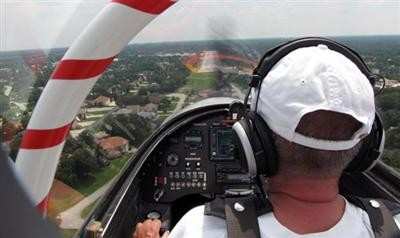Tandem Seating And A Bubble Canopy Is Refreshing Change
By Chris Batcheller
Walking up to the MySky booth at Oshkosh, the first thing that
ran through my head is that someone shrunk a modern military
trainer. Closer in, I noticed the tandem seating perched under a
large bubble canopy. Clearly this is NOT like the other high wing,
side by side LSA’s on the mall. The only thing that was
missing were training stripes and the squadron insignia on the
tail.

Greeting me at the airplane is Dieter Canje and Ret. USN Capt.
Peter S. Pierpont. Dieter has a soft European accent and is the CEO
and President of MySky Aircraft, Inc. Peter Pierpont is the Chief
Operating Officer and perhaps the fuel for the quasi-military feel
to the airplane. Both greeted me with smiles and firm hand shake as
they proceeded to proudly introduce me to the MySky ONE that is on
display.
In 2004 Dieter Canje decided that he wanted to offer an LSA that
was not the status quo, initially wanting to bring a European
aircraft to market in the United States. He quickly realized that
the airplanes in Europe were designed with a maximum weight of 475
Kg. With the new LSA rules in the states, you could design an
airplane that would have a maximum weight nearly 250 lbs heavier.
With an additional 250 lbs, Dieter recognized that the airplane
could be optimized.

He contacted several engineers and picked Martin Hollmann to
design the craft. The design started in the spring of 2005 and the
initial drawings were delivered in July of 2005. A year later the
initial design was complete.
Dieter selected some simple design requirements for the MSONE.
He felt that a great number of LSA’s were nothing more than
heavy ultralights and they didn’t fully take advantage of the
weight limit that the LSA rules allowed. The airplane must first
have looks. It must be a visually appealing airplane. Second the
airplane must feel like a real airplane. He thought that too many
LSA’s felt like an ultralight. Third, it must fly well. No
one would want to purchase a poor flying airplane. Last it must
sound like an airplane, and not like an ultralight.

So what did Martin Hollmann come up with? A two place airplane
with tandem seating, a low wing and a conventional tail. The
airplane has a bubble canopy, giving it the feel of a personal
fighter. The cockpit has 5 point harnesses and a beefy roll bar
between the seats. Under the hood is a Jabiru 3300 Engine with 120
horses and the ability to burn unleaded Mogas.
Enter Ret. USN Capt. Peter S. Pierpont, for now let’s just
call him Captain. After retiring from the Navy, Peter was a
production test pilot for Aviat and later served as a professor at
Embry-Riddle Aeronautical University. He also started and
successfully ran Eagle Works, a program that allowed the university
to collaborate with industry. The university offered contract
engineering to industry, allowing several projects to be developed
at low cost to the industry while offering the students a great
opportunity to learn. Some projects that Eagle Works contributed
were the first flight of the SMA Diesel Engine to Oshkosh and the
initial flights of the Minstral Rotary Engines on a Piper Arrow.
Unfortunately under new leadership, the university decided to
discontinue funding for Eagle Works, and the program was shut
down.
Captain met Dieter during the production of the first airframe.
Dieter was having a hard time managing the program while commuting
large distances. With the Captains expertise in managing
development programs, the adventure began. Peter supervised the
completion of the first airplane. After many long nights and 10
hours of engine ground run, the first prototype successfully flew
on the 10th of June, 2009. Currently the prototype has 70 hours of
flight time.

The prototype airplane has a composite airframe and the wing
have been tested to 10 G’s. The current prototype is heavier
than the weight target, but Peter is confident that the next
airframes will be lighter. The company only wants to produce the
airplane if it is confident that it can produce 100 airplanes per
year. Peter noted that the next step is to produce an additional 4
airplanes for pre-production evaluation and testing. Once the
design is frozen, full production can begin.
The airplane will be offered in a standard and a advanced
version with upgraded avionics. The company is developing a single
and dual axis autopilot that will offer heading, altitude, vertical
speed and altitude presets. Other options include a night flight
package and AmSafe Airbag Seatbelts. The standard airplane is
expected to sell for $117,500.
FMI: www.mysky.aero
 ANN's Daily Aero-Term (04.26.24): DETRESFA (Distress Phrase)
ANN's Daily Aero-Term (04.26.24): DETRESFA (Distress Phrase) ANN's Daily Aero-Linx (04.26.24)
ANN's Daily Aero-Linx (04.26.24) Airborne 04.22.24: Rotor X Worsens, Airport Fees 4 FNB?, USMC Drone Pilot
Airborne 04.22.24: Rotor X Worsens, Airport Fees 4 FNB?, USMC Drone Pilot Airborne 04.24.24: INTEGRAL E, Elixir USA, M700 RVSM
Airborne 04.24.24: INTEGRAL E, Elixir USA, M700 RVSM Airborne-NextGen 04.23.24: UAVOS UVH 170, magni650 Engine, World eVTOL Directory
Airborne-NextGen 04.23.24: UAVOS UVH 170, magni650 Engine, World eVTOL Directory






